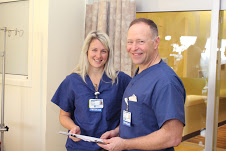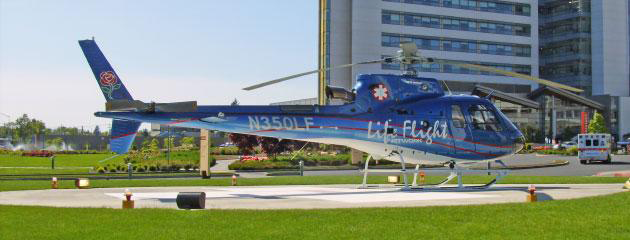This month, the PeaceHealth Southwest Medical Center gained a husband and wife team of doctors, Dr. Mark Foster, an emergency room physician, and Dr. Stephanie Sea, a trauma surgeon.
The Trauma Center
The PeaceHealth Southwest Medical Center Trauma team is comprised of physicians and nurses trained in the treatment of patients with severe traumas, and are equipped to handle any complexity and severity of surgical emergency –surgical critical care, general surgery and neuro-critical care. And all have expertise in the diagnosis, treatment and support of critically ill and injured patients.
The Trauma Center has a multi-disciplinary team consisting of trauma surgeons; orthopedic surgeons with special expertise in complex orthopedic injuries; neuro-surgeons trained in all aspects of managing traumatic brain and spine injuries; thoracic and vascular surgeons; reconstructive plastic surgeons; facial trauma surgeons; interventional radiologists with highly advanced capabilities; and emergency medicine specialists with expertise in stabilizing acute, life-threatening illness.
The Trauma Team
Currently, PeaceHealth has 10 trauma surgeons, and by fall there will be 11. Eventually, they would like to be up to 12 trauma surgeons. The team begins with Emergency Services Manager Sabrina Coggins and Director of Trauma Denise Haun-Taylor. Dr. Stephanie A. Sea is the newest member of the Trauma Team.
Dr. George C. Dulabon serves as medical director for Trauma and Acute Care Surgery, and as medical co-director for the Intensive Care Unit (ICU). Before joining PeaceHealth in 2012, Dulabon worked for 10 years in Erie, Pa., as a trauma and general surgeon. He also held many administrative positions, including medical director of surgery.
“The trauma surgeon treats the sickest of the sick, the highest complexity of trauma,” Dulabon said. “The trauma team does three separate jobs: trauma surgery, acute care surgery and surgical critical care, which provides depth of coverage for the hospital system.”

The Newest Trauma Surgeon, Dr. Stephanie Sea
When asked what it was about Dr. Stephanie Sea that impressed him, Dulabon said, “It was the high quality, based on her CV –that was the first clearing point. And the question was, is she going to mesh with this team –the energy and enthusiasm and how we help each other out, and doing the right thing for the patient?”
“The traits she (Sea) brings to the bedside are leadership and great communication,” Haun-Taylor said. “The ability to communicate effectively with the team regarding the plan and the direction of the care is paramount in the critical, fast-moving trauma setting. This communication along with clinical excellence and split-second decision making are crucial in order for the team to carry out their roles in caring for these patients.”
Sea said she chose to come work in Vancouver because she liked what PeaceHealth was doing for the community and Southwest Washington, and what they were bringing to the area. She also said she liked the trauma program, the department, the people and the team they had developed there.
“It was everyone, coming together here, with their multiple areas of expertise and style,” Sea said. “Everyone had training from all over, and it was their training and perspective –a really great balance of those further in their experience and those newer. That kind of mix provides backup and support, checks and balances of experience, and that benefits the patients.”
Sea is from Illinois, and has trained on the West Coast and the East Coast.
“My husband and I are from large cities – Philadelphia, New Orleans and New York for Mark. Los Angeles, Baton Rouge and Philadelphia for me,” she said. “Coming from Louisiana, I’ve done hurricanes and tornados, along with the more typical gunshot wounds.”
While Sea didn’t want to talk that much about herself, she has impressive credentials. After graduating in 2003 with a biological sciences degree from Augustana College in Illinois, and in 2008 with a doctorate in medicine from Southern Illinois University, she completed an internship in general surgery in 2009 and two residencies in general surgery, 2009-2012 and 2013-2015 at the Albert Einstein Medical Center.
Sea then went on to a Research Fellowship in pediatric surgery (2012-2013) at St. Christopher’s Hospital for Children, and a Fellowship in surgical critical care (2015-2016) at LAC+USC Medical Center, the Keck School of Medicine, University of Southern California (LAC+USC). There she was an instructor of critical care medicine; procedural course instructor and lecturer; medical student surgery clerkship. She served on a number of committees at LAC+USC Medical Center, such as Health Information Management, the 2015-2016 ICU Committee, ICU County Best Practices and Community Outreach/Prevention.
From November 2016 to the present, she served as clinical assistant professor of surgery at Louisiana State University’s School of Medicine. Why did Sea choose to be trauma doctor?
“The first step was doing surgery, and taking care of the sickest patients –taking a very sick patient and making a big difference, very quickly, in their condition,” she said. “It’s very different from surgical. The way things happen when someone comes into trauma, we don’t know where the problem is, we’re blind going into the OR, and we have to quickly find what the problem is.”
Sea said she can think of several reasons that she enjoys working in a trauma center.
“It’s very rewarding, and I’ve worked with a talented group of people,” she said. “Every day is different. I can help people at the most difficult and dangerous points in their life, and I can help people in a time of greatest need.”
The Mindset of the Trauma Surgeon
“In many trauma cases, the anatomy we are dealing with no longer looks like what is in the anatomy book,” Dulabon said. “You have to envision what it should look like, and find the source of the bleeding or of the problem. You have to make decisions rapidly –it’s the cost/benefit of the algorithm –and then implement. You can’t vacillate.”
“Trauma is orchestrated chaos, and they (the trauma team/doctor) act as conductors, to guide everything,” Sea said. “To direct and guide and keep everyone calm, and to be clear on roles so everyone moves forward as a team.”
Dulabon said that while much of the trauma in the big cities is routinely violent, the trauma team at PeaceHealth doesn’t see as much of that in the Southwest Washington area. He said it’s “95 percent blunt, like high-speed accidents, and that gives us the choice of not operating or operating.”
“Everyone at some point will experience some kind of trauma,” he said. “It’s also the ‘disease’ of younger folks, and we return them to normalcy. Then they have another 40 years of life because we were able to give back to them, and that’s very rewarding.”
The trauma center is monitored by the state every three years, and that process of always improving trauma also improves the whole workings of the hospital, Dulabon said.
“PeaceHealth has been a Washington-designated trauma center for 30 years, and that points to the administrative support for trauma at PeaceHealth Southwest,” Haun-Taylor said. “This support is important for the entire team and their contributions, while at the same time providing the dedicated resources needed for a constant state of readiness to care for trauma patients.”
“The trauma system is about getting patients to the closest center,” Haun-Taylor continued. “That leads to increased survival and optimal outcomes. We’re fortunate to have this program. And there’s no other Level II trauma center in Southwest Washington. We get a lot of transfers from Legacy Salmon Creek and from Longview, a sister PeaceHealth hospital.”
PeaceHealth gets people from as far east as White Salmon and as far north as Centralia. The catchment area is 635 square miles. They accept any patient for adult complex trauma.
“I’ve been in the area for 28 years, with 21 of those years dedicated to trauma,” Haun-Taylor said. “There was a starting point to getting to where we are today. I’ve never worked with a better team, so engaged, and they take care of the patients and each other. As a team, you get to a certain point and then you re-evaluate. We keep ourselves under the microscope of quality.”
“This is a center of excellence for any surgical emergency,” Haun-Taylor continued. “Not all states or communities have trauma care available. This is one of the premier trauma centers. It’s looked on as a model around the country.”




